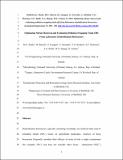| dc.contributor.author | Healy, Mark G. | |
| dc.contributor.author | Barrett, Maria | |
| dc.contributor.author | Serrenho, Ana | |
| dc.date.accessioned | 2014-11-10T10:51:33Z | |
| dc.date.available | 2014-11-10T10:51:33Z | |
| dc.date.issued | 2014-10-29 | |
| dc.identifier.citation | Healy, M.G., Barrett, M., Lanigan, G., Serrenho, A., Ibrahim, T.G., Thornton, S.F., Rolfe, S.A., Huang, W.E., Fenton, O. (2014) 'Optimizing nitrate removal and evaluating pollution swapping trade-offs from laboratory denitrification bioreactors'. Ecological Engineering, 74 :290-301. | en_US |
| dc.identifier.uri | http://hdl.handle.net/10379/4723 | |
| dc.description | Journal article | en_US |
| dc.description.abstract | Denitrification bioreactors, typically containing woodchips, are artificial sinks used to remediate nitrate (NO3-) losses on agricultural landscapes. Analysis of these bioreactors frequently considers their efficacy in terms of only a single contaminant (for example, NO3-), but does not consider other losses ammonium (NH4+), phosphorus (PO43-), methane (CH4), carbon dioxide (CO2) and nitrous oxide (N2O). In this study, laboratory-scale denitrifying bioreactors operated at hydraulic retention times (HRTs) ranging from 4 to 22 d, containing either lodgepole pine woodchips (LPW), lodgepole pine needles (LPN), barley straw (BBS) or cardboard, were investigated to elucidate operational optima considering three scenarios using: (1) only NO3- net fluxes (2) NO3-, NH4+ and PO43- combined fluxes (3) all fluxes (water and gaseous) combined. At the end of the experiment, after up to 745 days of operation, the bioreactors were destructively sampled for microbial analysis. In Scenario 1, there was a net removal in the bioreactors, which generally performed best at shorter HRTs. In Scenario 2, there was a net release of contaminants from all bioreactors, which substantially increased in Scenario 3. Total greenhouse gas emissions were highest for the cardboard bioreactors (296 g CO2-eq m-2 d-1) at the longest HRT, and were dominated by CH4 emissions. Highest N2O emissions emanated from LPN and LPW bioreactors, which also had a greater proportion of denitrifiers than the other bioreactors. Overall, considering all three scenarios, LPN bioreactors were the best performing at all HRTs. However, the long-term availability of its carbon source may be limited, as there was an 80% reduction over a 560 d period. | en_US |
| dc.description.sponsorship | Department of Agriculture, Fisheries and Food - Research Stimulus Programme 2007 (RSF 07 525) | en_US |
| dc.format | application/pdf | en_US |
| dc.language.iso | en | en_US |
| dc.publisher | Elsevier | en_US |
| dc.relation.ispartof | Ecological Engineering | en |
| dc.rights | Attribution-NonCommercial-NoDerivs 3.0 Ireland | |
| dc.rights.uri | https://creativecommons.org/licenses/by-nc-nd/3.0/ie/ | |
| dc.subject | Denitrification | en_US |
| dc.subject | Bioreactors | en_US |
| dc.subject | Greenhouse gas emissions | en_US |
| dc.subject | Pollution swapping | en_US |
| dc.title | Optimizing nitrate removal and evaluating pollution swapping trade-offs from laboratory denitrification bioreactors | en_US |
| dc.type | Article | en_US |
| dc.date.updated | 2014-11-10T08:32:55Z | |
| dc.local.publishedsource | http://dx.doi.org/10.1016/j.ecoleng.2014.10.005 | en_US |
| dc.description.peer-reviewed | peer-reviewed | |
| dc.contributor.funder | |~|Dept of Agriculture & Food |~| | |
| dc.internal.rssid | 7612097 | |
| dc.local.contact | Mark Healy, Dept. Of Civil Engineering, Room E210, Civil Engineering Building, Nui Galway. 5364 Email: mark.healy@nuigalway.ie | |
| dc.local.copyrightchecked | Yes | |
| dc.local.version | ACCEPTED | |
| nui.item.downloads | 676 | |


